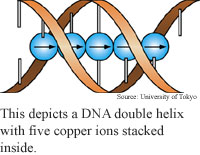
Artificial DNA stacks metal
atoms
In recent years, researchers have replaced some of DNA's natural bases with those that attach to metal atoms in order to coax DNA to organize metal ions into tiny structures.
Researchers from the University of Tokyo in Japan have tapped the method to form stacks of single metal ions.
The work shows that DNA can be used to precisely position and
control arrays of metal. The relatively simple method is a step toward
building and controlling tiny metal devices and nanomachines atom by atom.
DNA forms from four types of bases that pair up along a pair of sugar-phosphate backbones to form the familiar double helix. Previously, the Tokyo researchers had developed an artificial base close to the size and shape of natural DNA bases that attached to a copper ion. Ions are atoms that have more or fewer electrons than normal.
When the researchers mixed DNA containing the artificial bases into a room-temperature solution of copper ions, the new bases bound to the copper; when the DNA curled into a double helix, the copper ions ended up stacked neatly inside. The researchers used the method to make a stack of five ions.
The researchers are working on adding different metals to DNA molecules, and on forming tiny junctions; the ultimate goal is to construct metal molecular devices like wires and magnets, according to the researchers.
The work appeared in the February 21, 2003 issue of Science.
Radio tags give guidance
Laser made from single atom
Web searches tap databases
Heated plastic holds proteins
News briefs:
Reflective dust IDs substances
Rapid process shapes aluminum
3D display goes deeper
Artificial DNA stacks metal atoms
Teamed lasers make smaller spots
Glow shows individual DNA

Research Watch blog
View from the High Ground Q&A
How It Works
RSS Feeds:
News
Ad links:
Buy an ad link
Ad links: Clear History
Buy an ad link
|
TRN
Newswire and Headline Feeds for Web sites
|
© Copyright Technology Research News, LLC 2000-2010. All rights reserved.